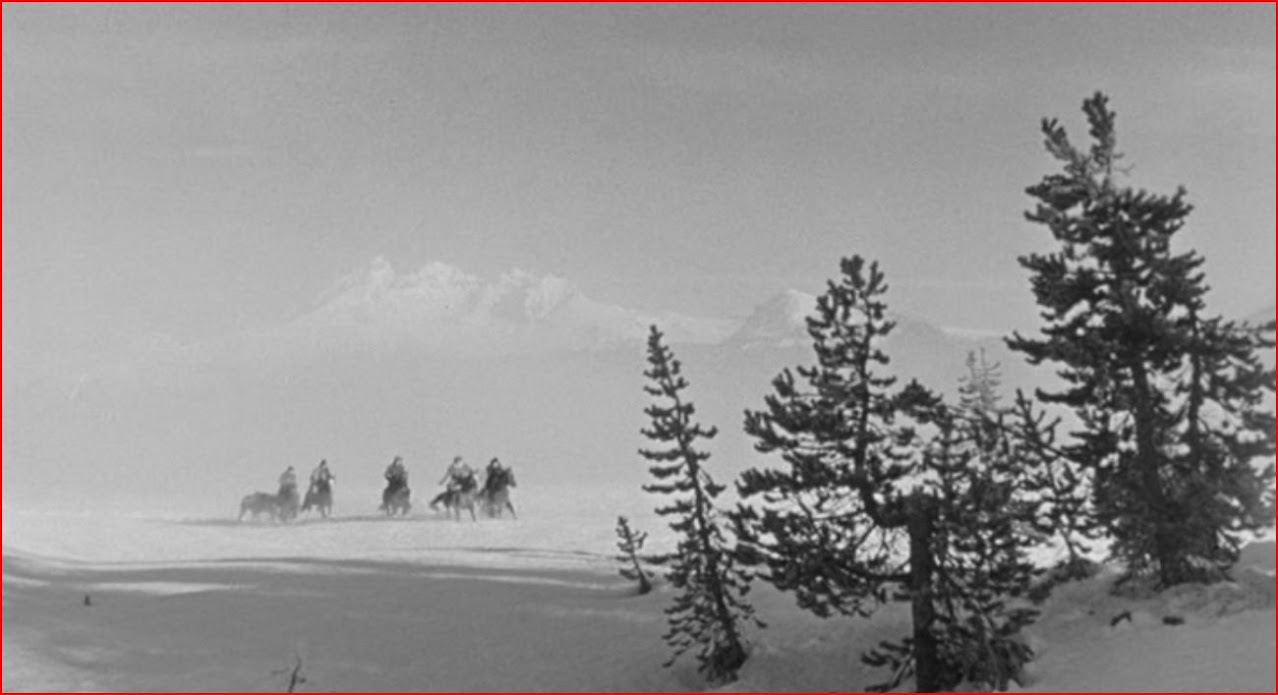

Above, Robert Ryan as the Cattleman. Below, Burl Ives as the Outlaw.

The bandits' appearance completely transforms the story. We might expect that the rivalry between Starett and Crain would remain in the foreground as both men deal with Bruhn's invasion. Instead, it virtually ceases to matter. Starett emerges as the hero because, confronted with the lawlessness he drove out years ago, he reverts to his earlier role as a town-tamer. Older and wiser, he knows he can't fight Bruhn's gang, either single-handedly or with the help of the peaceable townsfolk. De Toth illustrates this by having Starett beat down one bad guy (Jack Lambert) in a fistfight, only to have Bruhn order two more goons to pummel Starett into temporary submission.

To save the town, Starett has to use psychology, playing on the fissures within the gang. Bruhn's authority is the only thing holding the gang together and the only thing restraining his men from pillaging the town and raping the women. The director illustrates the menace when Bruhn finally relents and lets his men dance with the ladies. The camera whirls around the room as the clumsy, brutish males manhandle the women in a parody of dancing, while the gang's half-breed (hawk-nosed and typecast Frank De Kova) barely moves, telling his partner simply, "I want to look at you." In a way, this is the most violent scene in the movie. But it offers a chance at redemption to the gang's youngest member (David Nelson), who hasn't yet outgrown his conscience.

Bruhn is dying from a lung wound suffered during the robbery. If he dies, his men will tear the town apart. Starett's only option is to convince them that he knows a trail through the mountains that will open their lead on the pursuing cavalry. Then, when Bruhn inevitably passes, the chips can fall where they may in the snowy forest. Whether Starett makes it back or not, his recent feuds no longer matter to him. He's seen the face of savagery again and realizes how close he came to taking over that role himself.

Day of the Outlaw moves so far beyond its original storyline that it doesn't bother wrapping it in the expected ways. That may make the film seem incomplete, or make some viewers wonder whether the writers changed their minds early in the script. Burl Ives and his crew so dominate the middle of the movie that Ryan's redemption can seem underplayed. But Andre De Toth makes the film worth viewing as long as he doesn't trade his stark location for studio sets. He and Russell Harlan make this one of the last great black and white westerns, and the monochrome imagery only underscores the wintry misery of Bitters and environs. The film may not boast the most well-made plot, but that's the way it wants to be. It's nearly revisionist in its desire to transcend one of the genre's most common archetypes, but its redemptive finish reaffirms the genre's heroic values.
I absolutely loved the film. There have been a few Westerns made with noirish overtones, but this was the best amalgamations of the two in my reckoning. I particularly loved the dizzying camera work in the bar dance sequence, more so given the bleakness it was followed by. It in fact reminded me a lot of the bar dance sequences in a few of Bela Tarr's films - Satantango in particularly - though they were certainly nowhere as kinetic & adrenaline-pumping as the one here.
ReplyDeleteShubhajit, noir is in the bloodstream of the "adult western" thanks to the input of Anthony Mann, but Day of the Outlaw is a relatively late and admirable expression of it from De Toth, who did at least one great noir himself in Crime Wave.
ReplyDeleteFor a second opinion, here's Shubhajit's characteristically concise review of Day of the Outlaw at his always-readable Cinemascope blog.